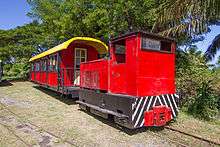Rail transport in Fiji
Rail transport in Fiji exists to move cut sugar cane to crushing mills. There used to be two horse-drawn street tramway systems, some other passenger systems, an underground mine system, and some tramways on construction projects.
Cane Trains

Tramways have been used to transport sugar cane from the fields to the mill since 1876 when a 2.4-kilometre (1.5 mi) horse tramway was constructed on the Selia Levu estate on the island of Taveuni. The Holmhurst Mill on Tavenui had tramways from 1882 of 2 ft 6 in (762 mm) narrow gauge. A tramway was also built on Mago Island.
Most cane tramways were of 2 ft (610 mm) gauge, on the main islands of Viti Levu and Vanua Levu. Steam engines were used, later replaced with diesel engines. Most of the mills and tramways were built by the Colonial Sugar Refining Company (CSR), an Australian-owned company, and transferred to the Fiji Sugar Corporation in 1973, when CSR withdrew from Fiji.
Many lines were on road reserve provided by the government, and combined road-rail bridges were common. Some passenger services were provided, such as the famous Free Train from 1915, with one or two trains a week from Lautoka to Kavanagasau and Rarawai on the Rarawai-Kavanagasau Light Railway.
In 1988, according to Cane Train, there were 645 kilometres (401 mi) of permanent cane railway in Fiji, for the Lautoka and Rarawai, and Penang mills on Viti Levu, and the Labasa Mill on Vanua Levu.
 Loco no 22 crossing Sigatoka bridge with a long train of empty wagons, near the end of the South Coast line
Loco no 22 crossing Sigatoka bridge with a long train of empty wagons, near the end of the South Coast line Loco no 21 crossing Nadi Back Road into the cane fields with a few empty wagons. The main line runs parallel to the road on left
Loco no 21 crossing Nadi Back Road into the cane fields with a few empty wagons. The main line runs parallel to the road on left Loco no 11 entering Lautoka with a long train of approximately 45 loaded wagons
Loco no 11 entering Lautoka with a long train of approximately 45 loaded wagons
Passenger Lines

In the 1970s a holiday resort on Malololailai Island in Nadi Bay built a short tramway from the air strip to the resort complex, using 2 ft (610 mm) gauge equipment from the Fiji Sugar Corporation.
The Coral Coast Railway Company on Viti Levu has operated return trips for visitors from Yanuca Island to Natadola Beach (16 km or 9.9 mi towards Nadi) from 1986, and also to Sigatoka.
Horse Tramways
In 1884 the Levuka Tramway Company operated a 2 ft 6 in (762 mm) gauge tramway along the streets of Levuka to connect warehouses with the wharves. Similar tramways were laid in the new capital of Suva in the 1880s, and were put on an official footing in 1891. Both were horse-operated, with the help of manpower.
Mine Railways
The Emperor Gold Mine at Vatukoula in northern Viti Levu used 2 ft (610 mm) gauge tramways underground, with 21 battery-electric locomotives.
Construction Tramways
Tramways were built for reclamation at Suva and Lautoka, airfield construction at Nadi (1941–42), tunnelling for the Suva sewerage system, and for the Monasavu hydroelectric scheme in the centre of Viti Levu in the 1980s.
References
- Cane Train: The Sugar-cane Railways of Fiji by Peter Dyer and Peter Hodge (1988: New Zealand Railway and Locomotive Society, Wellington) ISBN 0-908573-50-2, a revision and expansion of:
- Balloon Stacks and Sugar Cane by Peter Dyer and Peter Hodge (1961: New Zealand Railway and Locomotive Society, Wellington)
External links
![]() Media related to Rail transport in Fiji at Wikimedia Commons
Media related to Rail transport in Fiji at Wikimedia Commons
.svg.png)